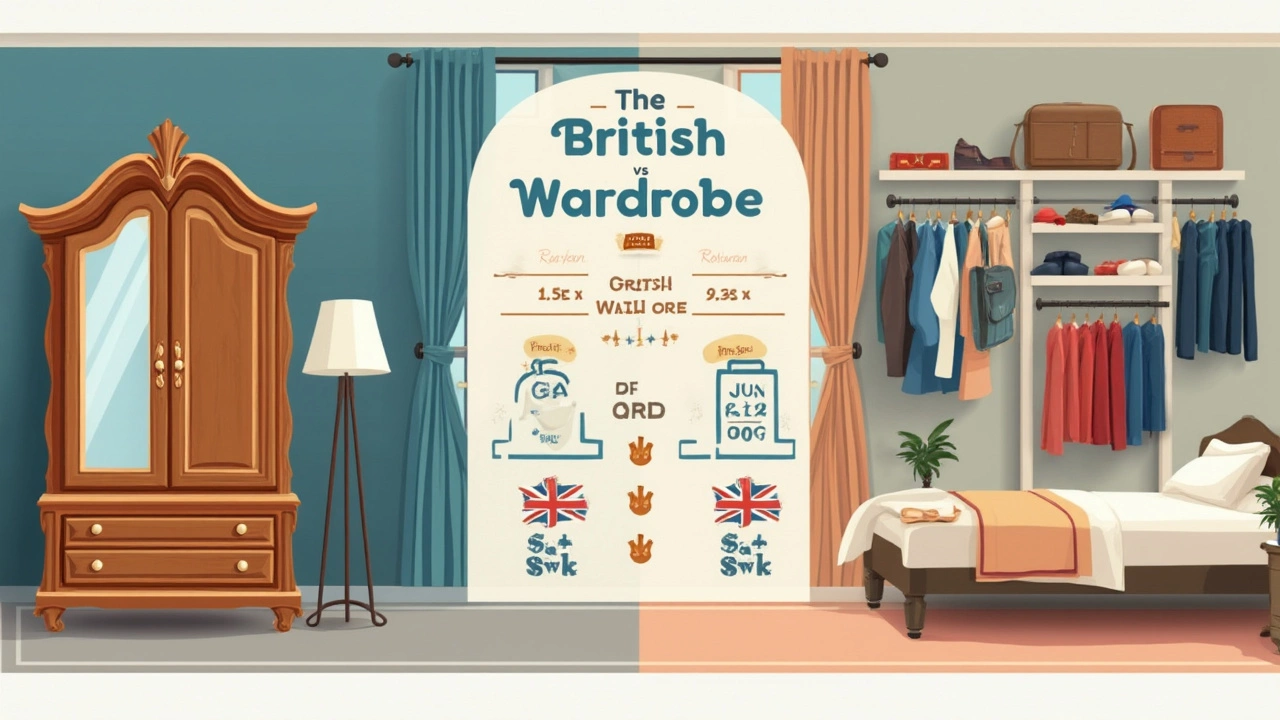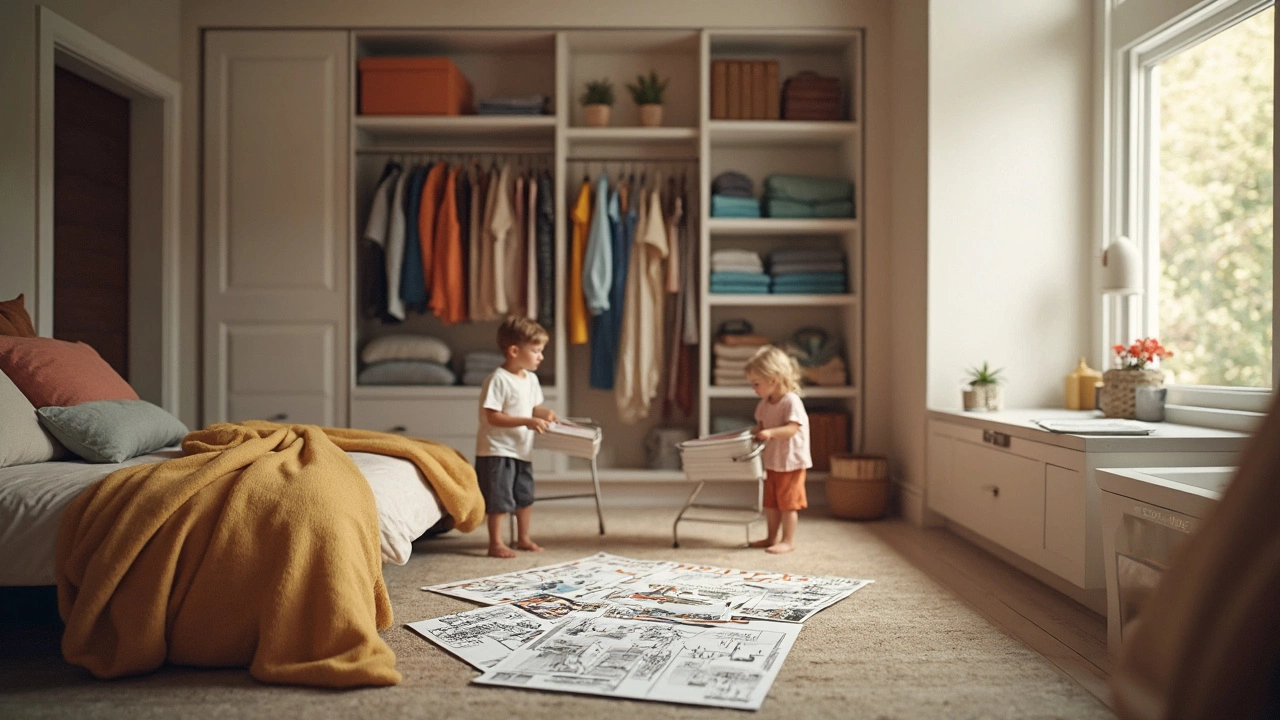Ever asked for a wardrobe in the U.S. and gotten blank stares? In America, nobody uses the word 'wardrobe' for the spot where they hang their shirts or stash shoes. Instead, you'll hear 'closet'—all day, every day. Walk into any American home and you'll see closets built right into the walls, with rods and shelves ready for piles of clothes.
If you're moving stateside or just binge-watching American TV shows, this is handy to know. Closet is the standard word for what the British call a wardrobe. Say 'Where’s your wardrobe?' in Chicago or Dallas, and folks might imagine you mean a fancy piece of old furniture, not the place they shove their laundry when guests arrive. Getting this bit of language right saves you confusion—and a little embarrassment.
- What's the American Word for Wardrobe?
- Why Do Americans Say 'Closet'?
- The Closet vs. Wardrobe: Key Differences
- Common Types of Closets in the U.S.
- Tips for Setting Up American-Style Closet Storage
What's the American Word for Wardrobe?
Across the United States, people almost never use "wardrobe" when talking about where they keep their everyday clothes. The actual word Americans say is closet. If you’re looking at American real estate listings or home interiors, you’ll see closet mentioned everywhere, whether it’s a walk-in, a reach-in, or tucked under the stairs.
This word swap isn’t just some casual slang. "Closet" shows up in the language of construction, home sales, and even building codes. Cities and towns often have minimum closet requirements per bedroom. Try checking out a new apartment in New York, and you’ll see the phrase "ample closet space" — not "wardrobe storage."
While Brits use "wardrobe" for both the furniture and the place you store clothes, Americans only say "wardrobe" when they mean an old-fashioned, stand-alone piece of furniture. Think those heavy wooden cabinets your grandma might have had. For Americans, everyday clothing storage is all about the closet, whether built-in or custom designed.
Here’s how Americans use these terms:
- Closet: Built-in space, usually with a door, shelves, and a rail for hanging clothes.
- Wardrobe: Freestanding cabinet with doors, less common in modern American homes.
- Armoire: A fancy, often decorative name for a large freestanding wardrobe, usually more at home on a period drama than in your average U.S. house.
So if you're ever in the states and need somewhere to hang your jacket, ask for the closet. That’s the word everyone will understand.
Why Do Americans Say 'Closet'?
So, why do Americans use the word 'closet' instead of 'wardrobe'? The answer goes way back to the way homes were built in the United States and how language changed along the way. When settlers first arrived, homes were small, and bulky furniture like the old-school wardrobe was a pain to move around. Builders started putting small storage rooms—closets—right into the walls.
The word 'closet' itself used to mean a private room, and over time in America, it changed to mean a small, enclosed space for storing stuff, especially clothes. By the late 1800s, most American homes had built-in closets. In other places, like the UK, people stuck with the portable wardrobe instead. That’s why Americans say closet and barely ever use 'wardrobe' for anything except talking about their overall clothing choices or a really old-fashioned piece of furniture.
Here’s a quick look at the early appearance of closets in U.S. homes:
| Year | U.S. Home Closet Trend |
|---|---|
| 1700s | Closets rare, mostly in wealthy homes |
| 1800s | Built-in closets become more popular |
| 20th Century | Closet included in nearly every bedroom |
If you ever look at real estate ads in the U.S., you'll see closets as a huge selling point. Terms like "walk-in closet" and "linen closet" pop up all the time. Around 97% of new American homes have bedroom closets, compared to only a fraction in many European homes. So when in the U.S., if you want to fit in, just call it a closet.

The Closet vs. Wardrobe: Key Differences
If you’re scratching your head over the difference between a closet and a wardrobe, you’re not alone. In the U.S., a closet is usually a built-in storage space with a door. It's literally part of the wall, not something that gets moved around. Wardrobes, on the other hand, are big pieces of furniture—think of those chunky standing cabinets you buy at IKEA or spot in old movies.
Let’s get really clear about what sets them apart. Here’s a quick rundown:
- Closet: Built into the house. You open the door, step (or lean) in, and use the hanging rod and shelves.
- Wardrobe: Freestanding. You move it wherever you like—bedroom, hallway, garage. Usually has doors, rods, maybe drawers inside.
- Space: Closets can be huge (sometimes even 'walk-in'), while wardrobes are limited by how wide and tall the furniture is.
Most American homes built after the 1940s have closets in almost every bedroom, according to the National Association of Home Builders. This means people rarely need to buy a wardrobe these days, unless they’re living in an old house or want an extra stylish touch for their clothes.
Want it all in a neat little chart? Check this out:
| Feature | Closet | Wardrobe |
|---|---|---|
| Permanent (Built-in) | Yes | No |
| Movable | No | Yes |
| Common in US homes | Yes | Rare |
| Customizable Size | Limited by house design | Buy to fit your space |
| Seen in Bedrooms | Almost always | Sometimes |
Long story short: if you’re in America, closets are a done deal, while wardrobes are more of a special occasion. Knowing the right word helps you shop smarter and makes moving or decorating way easier.
Common Types of Closets in the U.S.
When Americans talk about a closet, they could mean a bunch of different things. Every house or apartment has some version of these. Knowing the types helps if you’re moving, organizing, or shopping for furniture and storage.
- Walk-In Closet: This is the dream closet you see in home makeover shows. Walk-ins give you enough space to actually walk inside. You’ll find hanging rods, shelves, and sometimes even islands with drawers. According to a 2024 survey from the National Association of Home Builders, nearly 90% of new single-family homes built in the U.S. have a walk-in closet in the main bedroom.
- Reach-In Closet: Most American homes have at least one reach-in. These are the shallow closets with sliding or hinged doors, just deep enough to hold clothes on hangers. They're usually in smaller bedrooms, hallways, or entryways.
- Linen Closet: Found in or near bathrooms, these are narrow closets with shelves for towels, bedding, and toiletries. It's a staple in most suburban homes—few Americans store towels in their wardrobes.
- Coat Closet: Usually right by the main entrance, these closets hold jackets, umbrellas, and sometimes shoes. It’s the first place guests use when coming inside.
- Utility Closet: This is where cleaning supplies, vacuum cleaners, and sometimes the water heater or electrical panel live. It’s part of the storage deal in most homes, and Americans like having separate spots for different stuff.
Exact numbers vary, but this breakdown shows how popular closet types compare in the U.S.:
| Type | Percent of U.S. Homes with This Type |
|---|---|
| Walk-In Closet (primary bedroom) | 90% |
| Reach-In Closet | 98% |
| Linen Closet | 85% |
| Coat Closet | 80% |
| Utility Closet | 75% |
Pretty clear—closets run the show for storage in the U.S. Forget using a freestanding wardrobe unless you like antique furniture or you’re short on built-in space.

Tips for Setting Up American-Style Closet Storage
If you want to get the most out of your closet (yep, that's the usual American English word), you don’t have to stick with that jumble of hangers and piles of shoes at the bottom. Americans love organizing, and there are some tricks that really work—no matter how much space you've got.
- Use multiple hanging rods: American closets almost always have one rod for shirts and another below for pants or skirts. Doubling up makes the most of vertical space.
- Add shelves or cubbies: Shelves are perfect for sweaters or jeans that don’t belong on hangers. Cubbies help with shoes, bags, or stuff you grab every day.
- Try storage bins and boxes: Clear plastic bins let you see stuff at a glance. Store hats, scarves, or out-of-season clothes, and just stack the bins up or slide them under hanging clothes.
- Install hooks or hanging organizers: Hooks on the inside of the door or the wall are cheap and perfect for belts, ties, bags, or jewelry.
- Labels keep it clear: Especially helpful in big families—if you label shelves or bins, nobody gets confused, and you’ll actually stick to the setup.
Most American closets are built right into the room, and the standard size gives you more room to play than a standalone wardrobe. Here’s a quick look at closet size averages in the U.S. to help you plan your setup:
| Type of Closet | Average Width | Average Depth |
|---|---|---|
| Reach-in | 6 feet | 2 feet |
| Walk-in (small) | 5-7 feet | 5-7 feet |
| Walk-in (large/master) | 10+ feet | 10+ feet |
If you’re short on space, a basic reach-in closet organizer from popular stores like The Container Store or IKEA usually costs $150–$500 and can double the amount you can fit inside. Don’t feel stuck with whatever shelves or rods came with your house—most Americans buy extra organizers or even DIY their own.
One last tip: If you’re renting, check if the landlord is cool with you screwing stuff into the walls. Removable organizers or hanging racks are a safe bet if you can’t make permanent changes.


Write a comment